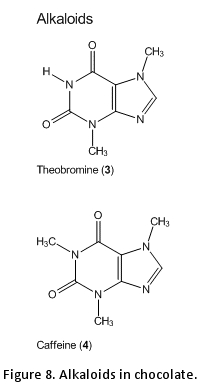Learn why chocolate, when consumed in reasonable amounts, can and may be a particularly tasty and valuable, though high-calorie part of a balanced nutrition.
Chocolate, A Healthy Food? [18]
Already in the ancient civilizations of the Middle Americas, cocoa was used for the treatment of various diseases. By mixing with other medicinal plants, the Aztecs developed a plethora of remedies, e.g., against infections, diarrhea, and coughs [17].
After conquering the Middle Americas, Europe adopted cocoa as a medicinal compound, from the second half of the 16th century. Cocoa improved the appetite; in phases of physical or mental weakness (depression), it was recommended as a stimulant, and in phases of hyperactivity, it equally served as tranquilizer. Cocoa was a popular remedy against many diseases of the inner organs, e.g., against a “weak stomach”, for the “stimulation of the kidneys” against “weak urine flow”, or for strengthening the intestines against constipation and hemorrhoids. In many traditional recipes, cocoa was admixed to the real medicinal plant, with the cocoa part serving as a means to facilitate the application and to improve the taste.
How Are Cocoa And Chocolate Evaluated From Today’s Point Of View?
Let us have a look at each of the components:
Antioxidants
At up to 18 % of their dry weight, cocoa beans have an unusually high content of polyphenols – such as catechin, epicatechin, and their oligomeric derivatives (Fig. 7) – as well as catechin esterfied with gallic acid, quercetin and other polyhydroxy compounds [18, 19]. These compounds are excellent radical scavengers and, as antioxidants, seem to provide some protection against cardiovascular diseases and cancer [13].
An increase in the amount of flavonoids in the blood is, however, only detected after the consumption of dark chocolate, not of milk chocolate [21, 22]. Although this is jet to be proven, animal experiments do at least hint at this tendency.
.gif)
Fat
As a plant product, chocolate does not contain any cholesterol. In addition, many studies have shown that stearic acid and cocoa butter do not lead to an elevation of the cholesterol levels and they also do not induce atherosclerotic diseases. However, this may not apply to high-risk groups, i.e., to patients with an extremely high cholesterol level.
Due to the addition of powdered milk, milk chocolate varieties contain low amounts of cholesterol.
Caffeine and Theobromine
Theobromine (3) and caffeine (4) (Fig. 8) have a  stimulatory effect on the central nervous system and the cardiovascular system, with theobromine having a much lower effect. Consumed in reasonable quantities, the amounts of alkaloids contained in chocolate or cocoa do not lead to any detectable physiological consequences.
stimulatory effect on the central nervous system and the cardiovascular system, with theobromine having a much lower effect. Consumed in reasonable quantities, the amounts of alkaloids contained in chocolate or cocoa do not lead to any detectable physiological consequences.
Theobromine does have physiological effects as an alkaloid. For example, after 7 days of administration of 500 mg/kg theobromine, the sperm production in male rats decreases. However, in order to reach this dose, a man would have to consume 50 bars of chocolate per day.
In contrast to man, several animal species degrade theobromine rather slowly. At extremely high doses, this may have harmful effects. Acute theobromine poisening was observed mainly in dogs that were spoiled with too much chocolate. Vomiting, diarrhea, and an accelerated heartbeat are the first and often underestimated symptoms, which in rare cases may also result in the death of the animal [23].
The toxic dose for dogs amounts to 100 mg/kg body weight. A 10 kg dog reaches this value after eating one bar of plain chocolate [24].
Only amounts of up to 20 mg/kg are acceptable, according to the American Society for the Prevention of Cruelty for Animals.
Mineral Nutrients
Cocoa is rich in mineral nutrients and, in this regard, is a high-value food. Overall, at a content of 10.5 mg Fe/100 g, cocoa is besides curry powder the most iron-rich food [11].
Migraine
In some people, the consumption of chocolate can induce a migraine attack. Phenylethylamine was at first suspected to be the causative element because it showed a vasoconstrictive effect in animal experiments. However, the concentration of phenylethylamine in cocoa products is far too low to produce a physiological effect.
This contradiction was solved by a double-blind study on predisposed patients. According to this study, the correlation between chocolate consumption and migraine is only based on the fact that, in this patient group, conditions of stress or the menstrual cycle induce both migraine and the desire for chocolate at the same time. A cause-effect connection could be excluded [11].
Other Side Effects
The sugar contained in chocolate is harmful for diabetics and, in case of insufficient oral hygiene, can lead to tooth decay. At a nutritional value of more than 500 kcal/100 g, excessive consumption of chocolate can lead to obesity and the accompanying health problems.
Conclusion
Overall, chocolate, when consumed in reasonable amounts, can and may be a particularly tasty and valuable, though high-calorie part of a balanced nutrition.
Sex, Drugs And Chocolate
Three qualities of chocolate are persistently propagated:
- It has a soothing effect,
- It provides a feeling of elation and
- It acts as an aphrodisiac.
So, it is no surprise that people in many circumstances of life feel the desire for a piece of chocolate. On the one hand, this is a manifestation of the desire for the agreeable taste and the pleasurable feeling while the chocolate is melting on the tongue; on the other hand, this could also have physiological reasons.

Several theories have been suggested, e.g., the increase in the level of serotonin, the effects of theobromine and phenylethylamine, and magnesium deficiency [11]. The results of innumerable experimental studies create a rather confused picture:
The uptake of the natural amino acid tryptophane (Fig. 9) can increase the concentration of serotonin in the central nervous system.
Serotonin is a neurotransmitter and transduces signals between two nerve cells. The amplitude of the serotonin level has far-reaching physiological consequences, e.g., a change in mood. Simplistically, serotonin is designated as “happiness hormone”.
Tryptophane is a natural amino acid contained in all proteinaceous foods; in the body, it can be metabolized to serotonin. However, the tryptophane content of chocolate is far too low to induce a physiological effect. Also caffeine and theobromine, both of which are physiologically effective compounds, are contained in cocoa and chocolate in far too low concentrations in order to induce a change of mood.
Phenylethylamine is a highly effective compound that is structurally related to amphetamines. Several derivatives of 2-phenylethylamine show stimulatory effects (stimulatory amines). The first compound in this series was amphetamine (2-amino-1-phenylpropane); other examples are pervitin and the recreational drug ecstasy.
As phenylethylamine is quickly metabolized in the body and as its concentration in chocolate is very low, a physiological effect can be excluded.
In this context, a study by Michener and Rozin [25] is especially convincing: According to this study, the pathological craving for chocolate did not diminish even after administration of all the physiologically active components of cocoa. The desire for chocolate  therefore seems not to be physiologically but rather psychologically motivated. This is underlined by observations showing that the consumption of chocolate increases in phases of emotional stress and especially in women during the premenstrual phase.
therefore seems not to be physiologically but rather psychologically motivated. This is underlined by observations showing that the consumption of chocolate increases in phases of emotional stress and especially in women during the premenstrual phase.
As chocolate can create a feeling of emotional elation, there is the danger of addiction for predisposed people [26]. Chocolate addiction is an eating disorder that should be treated only in conjunction with professional support or in self-help groups.
The continually purported aphrodisiac effect of cocoa is based on reports of the Spanish conquerors of the Middle Americas. Although no aphrodisiacally active substance could be detected in cocoa, and although historians judge the corresponding descriptions as highly exaggerated, the belief in this effect is deeply anchored in the population.
Prof. Klaus Roth
Freie Universität Berlin, Germany.
The article has been published in German in:
and was translated by Monika Kortenjann.
References
[17] T. L. Dilllinger et al., J. Nutr. 2000, 130, 2057S.
[18] A. T. Borchers et al., J. Med. Food 2000, 3, 77. DOI:10.1089/109662000416285
[19] L. J. Porter et al., Phytochemistry 1991, 30, 1657. DOI: 10.1016/0031-9422(91)84228-K
[20] C. Heiss et al., J. Amer. College. Cardiol. 2005, 46, 1276. DOI: 10.1016/j.jacc.2005.06.055
[21] M. Serafini et al., Nature 2003, 424, 1013. DOI: 10.1038/4241013a
[22] M. Serafini et al., Nature 2003, 426, 788. DOI: 10.1038/426788a
[23] M. U. Eteng et al., Plant Foods Hum. Nutr. 1997, 51, 231. DOI: 10.1023/A:1007976831684
[24] http://vetmedicine.about.com
[25] W. Michener, P. Rozin, Physiol. Behav. 1994, 56, 419. DOI: 10.1016/0031-9384(94)90283-6
[26] www.nakos.de (German); www.oa.org (English)
► Missed Part I or Part II?
Chocolate – The Noblest Polymorphism I and Chocolate – The Noblest Polymorphism II
Other articles by Klaus Roth published by ChemViews magazine:
- In Espresso — A Three-Step Preparation
Klaus Roth proves that no culinary masterpiece can be achieved without a basic knowledge of chemistry
DOI: 10.1002/chemv.201000003 - In Chemistry of a Hangover — Alcohol and its Consequences
Klaus Roth asks how a tiny molecule like ethanol can be at the root of so much human misery?
DOI: 10.1002/chemv.201000074 - In Sparkling Wine, Champagne & Co
Klaus Roth shows that only chemistry can be this tingling
DOI: 10.1002/chemv.201000047 - In The Chemist’s Fear of the Fugu
Klaus Roth shows the chemist’s fear of the fugu or pufferfish extends as far as the distinctive and intriguing poision it carries
DOI: 10.1002/chemv.201000104




